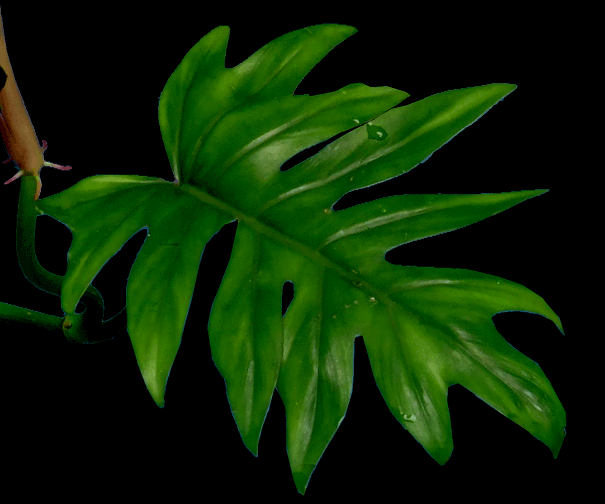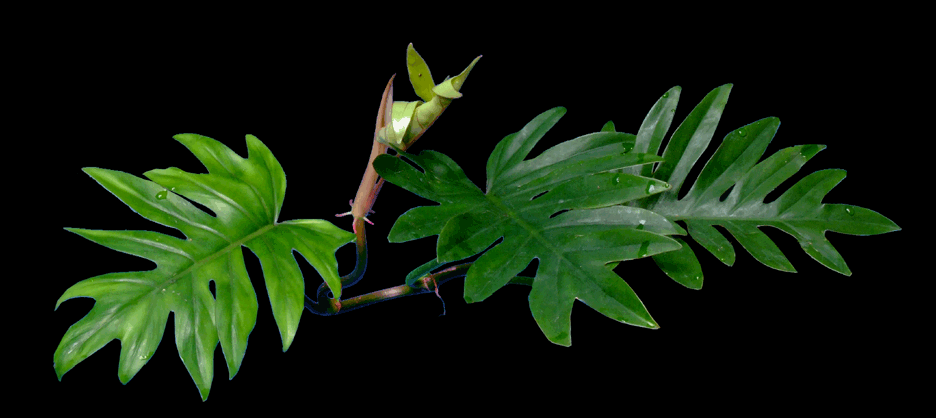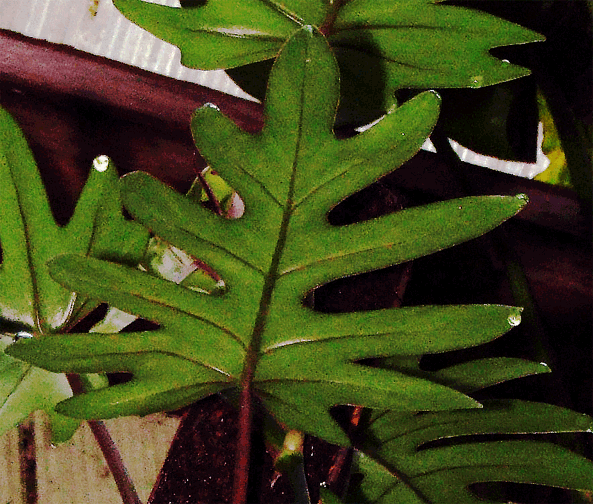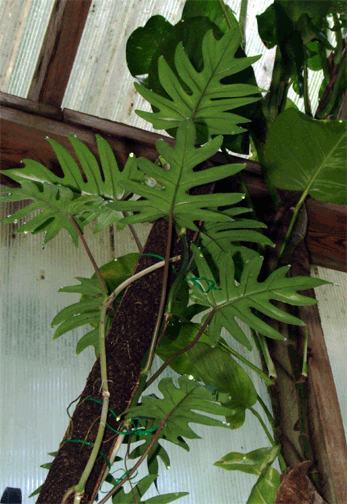![]()
Aroids and other genera in the Collection
Take the Tour Now?
Orchids
The
Exotic Rainforest
Plants in
the Exotic Rainforest Collection
Images on this website are copyright protected. Contact
us before attempting to reuse.
In depth information on how to grow Philodendron species, Click this Link
Within our collection we have many species of Philodendron. If you are seeking other photos, click this link
Philodendron mayoi
E.G. Gonçalves

Philodendron mayoi
E.G. Gonçalves
Sometimes spelled incorrectly as "Philodendron mayoii"

 Grower Russ Hammer pointed out on a
post on the UBC plant forum when asked to identify an unidentified
Philodendron specimen, "I
notice the petiole is reddish. If it has very pale reddish
veins on the reverse of the leaf, I'd say much more confidently that
it's P. mayoi." Both the petiole
and veins on the reverse of the leaf blade are reddish offering an
additional positive method of identifying Philodendron mayoi.
Grower Russ Hammer pointed out on a
post on the UBC plant forum when asked to identify an unidentified
Philodendron specimen, "I
notice the petiole is reddish. If it has very pale reddish
veins on the reverse of the leaf, I'd say much more confidently that
it's P. mayoi." Both the petiole
and veins on the reverse of the leaf blade are reddish offering an
additional positive method of identifying Philodendron mayoi.
Sometimes spelled incorrectly as "Philodendron mayoii"
Philodendron mayoi (MAY-o-e)
is a recently identified smaller bladed Philodendron species from
Brazil. Philodendron mayoi was first published in the Royal Botanic
Gardens Kew Bulletin in the year 2000 by Dr. Eduardo G. Gonçalves, (gon-ZAL-vas), Brazil's
best known botanical aroid scientist.

Found in the rain forests of
Brazil's Distrito Federal and Distrito Goias, Philodendron
mayoi is reported by Dr. Gonçalves to be both terrestrial
(creeping along the ground) and hemiepiphytic. A hemiepiphyte
(hem-a-EPA-fit) is a
species that can begin life either growing out of the ground
and then climb a tree or root on a tree as an epiphyte and
then grow roots down to the soil. Epiphytic aroid species
are placed on a tree branch in the droppings of a bird or small
animal who has eaten
the fruit of the Philodendron species.
With a dark green upper
surface to the leaf blade, the species is deeply pinnatified
(divided similar to the fronds of a palm) with 4 to 6 lobes on
either side of the blade. The leaf blades of our
specimen are approximately 18cm (7 inches) long. Dr.
Gonçalves
notes that only hemiepiphytic plants
were found producing and inflorescence.
 Grower Russ Hammer pointed out on a
post on the UBC plant forum when asked to identify an unidentified
Philodendron specimen, "I
notice the petiole is reddish. If it has very pale reddish
veins on the reverse of the leaf, I'd say much more confidently that
it's P. mayoi." Both the petiole
and veins on the reverse of the leaf blade are reddish offering an
additional positive method of identifying Philodendron mayoi.
Grower Russ Hammer pointed out on a
post on the UBC plant forum when asked to identify an unidentified
Philodendron specimen, "I
notice the petiole is reddish. If it has very pale reddish
veins on the reverse of the leaf, I'd say much more confidently that
it's P. mayoi." Both the petiole
and veins on the reverse of the leaf blade are reddish offering an
additional positive method of identifying Philodendron mayoi.
All Philodendron sp.
are aroids. An aroid is a plant that reproduces via the production of
an inflorescence. Most people
think the spathe of the inflorescence is a "flower", it is not. The spathe is simply a
modified leaf
appearing to be
a hood . If you explore the inflorescence with a magnifying
glass when it is ready to be pollinated there are very tiny flowers and
that can be seen on the spadix at the inflorescence' center. The
spathe which is sometimes shaped like a hood. Inside the
spathe is the spadix which somewhat resembles an elongated pine
cone.
The spadix is a spike
on a thickened fleshy axis which can produce tiny flowers.
When prepared to reproduce, the spadix produces male, female
and sterile flowers normally separated by a sterile zone.
The tiny male flowers produce pollen and the tiny female flowers are
receptive to pollen. However, most are cleverly divided
by nature to keep the plant from being self pollinated. Nature's
preferred method is to have insects (beetles) pick up the pollen from
one plant and carry it to a second plant to keep the species strong.
The spathe of Philodendron mayoi
is green on the outside and white inside. However, specimens
of Philodendron mayoi that
produce inflorescences are extremely uncommon according to Dr.
Gonçalves' technical description.
A fast growing vine when
running along the ground, in it's native Brazil
Philodendron mayoi is common in ravines and along streams. It
is also found growing on limestone outcroppings.
 The aroid has been
in collections since approximately the year 2000 but many have it
tagged as "P. mayoii". P. mayoi has also appeared for sale on eBay
under the spelling "mayoii" which according to the
original published scientific description as well as TROPICOS
(a service of the Missouri Botanical Garden) is incorrect.
The aroid has been
in collections since approximately the year 2000 but many have it
tagged as "P. mayoii". P. mayoi has also appeared for sale on eBay
under the spelling "mayoii" which according to the
original published scientific description as well as TROPICOS
(a service of the Missouri Botanical Garden) is incorrect.
 The aroid has been
in collections since approximately the year 2000 but many have it
tagged as "P. mayoii". P. mayoi has also appeared for sale on eBay
under the spelling "mayoii" which according to the
original published scientific description as well as TROPICOS
(a service of the Missouri Botanical Garden) is incorrect.
The aroid has been
in collections since approximately the year 2000 but many have it
tagged as "P. mayoii". P. mayoi has also appeared for sale on eBay
under the spelling "mayoii" which according to the
original published scientific description as well as TROPICOS
(a service of the Missouri Botanical Garden) is incorrect.
Philodendron mayoi
was named in honor of
aroid botanist Dr. Simon Mayo who
works
at The Royal Botanic Gardens Kew primarily with Brazilian
Philodendron species. Simon is also one of the authors of the
detailed scientific text The Genera of Araceae.
We grow Philodendron mayoi in moderately bright
light in a fast draining soil mixture of good potting soil, extra
peat, orchid bark, and Perlite™. To display the plant best,
give it something to climb. The plant is easily reproduced
from cuttings which can simply be placed in loose damp soil. Our specimen was a gift from Florida collector
Russ Hammer.
Philodendron species are
known to be highly variable and not every leaf of every specimen
will always appear the same. This link explains in
non-technical terms natural variation and
morphogenesis within aroid and other species.
Click
here.
Want to learn more
about aroids?
Join the International Aroid Society: http://www.exoticrainforest.com/Join%20IAS.html
Join the International Aroid Society: http://www.exoticrainforest.com/Join%20IAS.html